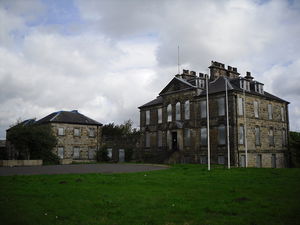Annotation:Cumbernauld House: Difference between revisions
No edit summary |
No edit summary |
||
| Line 6: | Line 6: | ||
<Br> | <Br> | ||
John (possibly Henry) Playford published the melody in 1687 in the fifth edition of '''Apollo's Banquet''' (p. 58) under the title "The Duke of | John (possibly Henry) Playford published the melody in 1687 in the fifth edition of '''Apollo's Banquet''' (p. 58) under the title "The Duke of | ||
Albany's Tune," and John Glen<ref>John Glen, '''Early Scottish Melodies''' (1900, p. 142) says it is probably contained in the Blaikie's MS. of 1692, where it goes under the name of "My Lord Aboyn's Ayre". The melody was used for the song "Where winding Forth adorns the vale", printed in James Johnson's '''Scots Musical Museum, vol. II''' (Edinburgh, 1788, Song 142, p. 149), with words by Scots poet Robert Ferguson<ref>Although Ferguson died young, poet Robert Burns admired his work and caused a stone to be erected in the | Albany's Tune," and John Glen</ref>John Glen, '''Early Scottish Melodies''' (1900, p. 142) says it is probably contained in the Blaikie's MS. of 1692, where it goes under the name of "My Lord Aboyn's Ayre". The melody was used for the song "Where winding Forth adorns the vale", printed in James Johnson's '''Scots Musical Museum, vol. II''' (Edinburgh, 1788, Song 142, p. 149), with words by Scots poet Robert Ferguson<ref>Although Ferguson died young, poet Robert Burns admired his work and caused a stone to be erected in the | ||
Canongate Churchyard, where he is buried.</ref> (1750-1774. They begin: | Canongate Churchyard, where he is buried.</ref> (1750-1774. They begin: | ||
<blockquote> | <blockquote> | ||
Revision as of 05:36, 11 March 2024
X:1 T:Lord Aboyne’s welcome or Cumbernauld house M:C L:1/8 R:Air Q:”Slow” B:Francis Barsanti – “Collection of Old Scots Tunes” (Edinburgh, 1742, p. 6) F: https://vmirror.imslp.org/files/imglnks/usimg/b/b0/IMSLP94625-PMLP194938-Barsanti_A_Collection_of_Old_Scots_Tunes.pdf N:Francis Barsanti (1690-1775) was an Italian flautist, oboist and composer who spent N:most of his life in London and Edinburgh. Z:AK/Fiddler’s Companion K:G V:1 G>A|B>AB>d {c}B2 (AG)|E>DEG A2 B>d|e2 (d>c) d(BTAG)|(D>E)(G>A) G2:| |:TB>A|G>AB>c {Bc}d3e|Td(c/B/) AB d2 zd|e>fg>a Tf2 (g/f/e/d/)|B2 e>f Te3d| g>a (g/a/b) B2 (c/B/TA/G/)|AB {e}d(c/B/) A2 B>d|Te2 d>c d(BTAG)|(D>E)(G>A) G2:|] V:2 clef = bass z2|G,,2D,2G,2 zB,|C3G,D,2G,,2|C,>CB,>A, B,,2C2|D2D,2G,2:| z2|G,2 G,>A, B,>A,B,>C|B,2 zG, D,DB,G,|C,2 z^C, ^D,B,,E,A,|B,2B,,2 E,EDC| B,,2 zD, G,2 zG,,|C,2G,,2D,2G,,2|C,>CB,>A, B,2C2|D2D,2 G,2:|]

John (possibly Henry) Playford published the melody in 1687 in the fifth edition of Apollo's Banquet (p. 58) under the title "The Duke of
Albany's Tune," and John Glen</ref>John Glen, Early Scottish Melodies (1900, p. 142) says it is probably contained in the Blaikie's MS. of 1692, where it goes under the name of "My Lord Aboyn's Ayre". The melody was used for the song "Where winding Forth adorns the vale", printed in James Johnson's Scots Musical Museum, vol. II (Edinburgh, 1788, Song 142, p. 149), with words by Scots poet Robert Ferguson[1] (1750-1774. They begin:
Where winding Forth adorns the vale,
Fond Strephon once a shepherd gay,
Did to the rocks his lot bewail,
'And thus addresst his plaintive lay.
'O Julia, more than lilly fair,
More blooming than the op'ning rose,
How can thy breast relentless wear.
A heart more cold than winter's snows.
- ↑ Although Ferguson died young, poet Robert Burns admired his work and caused a stone to be erected in the Canongate Churchyard, where he is buried.

